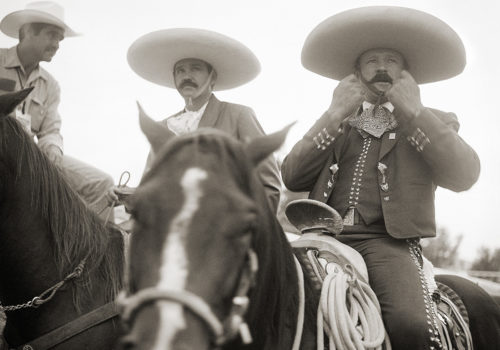Daniel S. Borris’ photographs have appeared in The New York Times, Rolling Stone, Smithsonian, The Washington Post, Vanity Fair, GQ, and Esquire among many others. His clients in the advertising and music industries have included The Gap, American Express, and Sony and Atlantic Records. His work has been honored by Communication Arts, American Photography, The Art Directors Club of New York, and he is a recipient of The Artist Foundation of San Antonio Grant. He has exhibited his work at Blue Star Contemporary Art Museum, The McNay Art Museum, Instituto Cultural de México, and Gallery Nord among others. Daniel S. Borris is an American photographer living in San Miguel de Allende, Mexico. https://dsborris.myportfolio.com
Patricia Lanza : What is the history behind the Mariachis and Mexican Cowboys (Los Charros)? How do these two connect and the reason for this series together? Daniel S. Borris : I’m far from being an expert on the history of Charros and Mariachis, but as I understand it Charros (Mexican Cowboy/Rodeo riders) originated with the arrival of the Spaniards and Hacienda culture. Mariachi music of course has European roots with its instrumentation but grew out of Charro culture. Mariachis were and are the musicians that played at all kinds of celebrations and special occasions. When you go to a Mexican Charreada (Rodeo) there’s always Mariachi music. The two go hand in hand to create the experience.
All of this began in the state of Jalisco, also the home of Tequila (both the town and drink). To me these three things all go together, Charros, Mariachis, and Tequila. It’s the Mexico that’s known around the world, and when you’re in Jalisco you’re saturated with the pride of this culture (there are of course the profound roots of indigenous culture, but that’s a different story).
Patricia Lanza : Where and when did you shoot this series, what was your process in the photographic shoot? (technical info here)
Daniel S. Borris : My friend and great photographer Russell Monk and I worked on this project together. I was living in San Miguel de Allende at the time (and still do), Russell would come down often. We had heard of The International Mariachi and Charro Festival so being curious guys we garnered some press passes and traveled over to Guadalajara to check it out.
We’d collaborated a little bit before this trip and it worked because Russell and I have pretty different shooting styles and techniques. He’s got a fast technique, more of a combination director/street shooter, I’m a slower big camera photographer. My images here were shot with an old twin lens Rolleiflex, a Pentax 6/7, and a Linhof 4×5 field camera. At that time, you could still get Polaroid Type 55 positive/negative film. It gave you an instant 4×5 neg of amazing quality. Ansel Adams actually wrote a technical guide book to it and other Polaroid films. Sadly, that’s all disappeared. I set up the 4×5 in a square located next to a cathedral. We’d grab Mariachi’s as they strolled around. I wanted a very formal look, almost early 20th century feel to the portraits; serious, proud and formal, which is the history and vibe of Charros and Mariachis. I’d stand them in front of the stone wall of the cathedral, adding more to the historic feel that I wanted.
Patricia Lanza : What is the symbolism (form and function) of the dress apparel?
Daniel S. Borris : Both Mariachis and Charros wear similar apparel, tight pants, short jackets, and big sombreros. These all had practical uses for the charros, protection from the sun, chaparral and elements. Originally this clothing was simple, made of leather and without the adornment we see today. It was working attire, and in fact a working-class attire in the Spanish caste system. The more formal style with intricate embroidery and silver came later in the late 19th century and grew into what we see today. There are different levels of this clothing, from the more utilitarian to the amazing peacock versions. And of course, there are many women riders and mariachi musicians, their traditional look is in long skirts.
Patricia Lanza : Where has this series been published and or exhibited? What do you hope to do with this work?
Daniel S. Borris : This work was originally shown in San Miguel de Allende, and then was exhibited at the Instituto Cultural de Mexico in San Antonio, Texas. That really was the perfect venue for this work since San Antonio is such a bicultural city. Since this is a pretty limited body of work, not a deep dive, I think it’d be great to have it published in a small way, perhaps in a magazine format.
Patricia Lanza : What are you working on now?
Daniel S. Borris : I’m currently working on a series of photographs with the working title of Monumental. This is recent work I shot in Europe and the Middle East and is a collaboration between myself and the Mexican poet, Valerie Mejer. She and I have collaborated previously on a series I did of Kudzu vines in Georgia We also worked together along with Poet Forrest Gander on a body of work titled, Las Canchas: Ball Courts of Mexico. This was a series of landscapes of rural Mexican soccer fields.
















